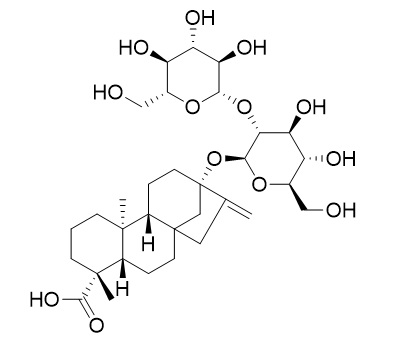Steviolbioside
Steviolbioside is a natural sweetener, it presents notable inhibition on human hepatocarcinoma cell Hep3B, human breast cancer cell MDA-MB-231 and human pancreatic cancer cell BxPC-3, thus, steviolbioside could be a potential remedy for human breast cancer.
Steviolbioside also exhibits moderate antituberculosis activity against M. tuberculosis strain H37RV in vitro.
Inquire / Order:
manager@chemfaces.com
Technical Inquiries:
service@chemfaces.com
Tel:
+86-27-84237783
Fax:
+86-27-84254680
Address:
1 Building, No. 83, CheCheng Rd., Wuhan Economic and Technological Development Zone, Wuhan, Hubei 430056, PRC
Providing storage is as stated on the product vial and the vial is kept tightly sealed, the product can be stored for up to
24 months(2-8C).
Wherever possible, you should prepare and use solutions on the same day. However, if you need to make up stock solutions in advance, we recommend that you store the solution as aliquots in tightly sealed vials at -20C. Generally, these will be useable for up to two weeks. Before use, and prior to opening the vial we recommend that you allow your product to equilibrate to room temperature for at least 1 hour.
Need more advice on solubility, usage and handling? Please email to: service@chemfaces.com
The packaging of the product may have turned upside down during transportation, resulting in the natural compounds adhering to the neck or cap of the vial. take the vial out of its packaging and gently shake to let the compounds fall to the bottom of the vial. for liquid products, centrifuge at 200-500 RPM to gather the liquid at the bottom of the vial. try to avoid loss or contamination during handling.
Appl. Sci.2020, 10(23), 8729
Int J Mol Sci.2021, 22(8):4211.
J Biosci.2020, 45:46.
Biomol Ther (Seoul).2023, 31(1):40-47.
J Nat Med.2022, 76(1):59-67.
Biochem Biophys Res Commun.2018, 505(1):194-200
Food Chem.2024, 460(Pt 1):140472.
Rep.Grant.Res.,Asahi Glass Foun.2023, No.119.
Antioxidants (Basel).2022, 11(8):1471.
University of East Anglia2023, 93969.
Related and Featured Products
Chemistry of Natural Compounds, 2011, 46(6):902-5.
Antituberculosis activity of glycosides from Stevia rebaudiana and hybrid compounds of steviolbioside and pyridinecarboxylic acid hydrazides[Reference:
WebLink]
Stevioside and Steviolbioside, glycosides from Stevia rebaudiana Bertoni, in addition to hybrid compounds synthesized from Steviolbioside and the antituberculosis drug isoniazid and its isomer nicotinic acid hydrazide exhibited moderate antituberculosis activity against M. tuberculosis strain H37RV in vitro (MIC = 7.5, 3.75, 5, and 10 μg/mL, respectively).
Food Chem. 2016 Apr 1;196:155-60.
Production of a bioactive sweetener steviolbioside via specific hydrolyzing ester linkage of stevioside with a β-galactosidase.[Pubmed:
26593477]
METHODS AND RESULTS:
A β-galactosidase from Kluyveromyces lactis was found to specifically catalyze hydrolysis of the glycosyl ester linkage of stevioside to yield Steviolbioside, a rare sweetener that also exists in Stevia rebaudiana leaves.
In a packed bed reactor, a reaction coupling separation was realized and a production yield of Steviolbioside reached 90% in 6 h. The hydrolysis product Steviolbioside presented higher cytoxicity on human normal cells (hepatocytes cell L02 and intestinal epithelial cell T84) than stevioside did. Comparing to the typical chemotherapy agent, 5-fluorouracil (5-FU), Steviolbioside presents much lower cytotoxicity on all assayed human normal cells; it presented notable inhibition on human hepatocarcinoma cell Hep3B, human breast cancer cell MDA-MB-231 and human pancreatic cancer cell BxPC-3.
CONCLUSIONS:
The remarkable inhibition on MDA-MB-231 cells makes Steviolbioside a potential remedy for human breast cancer, when Steviolbioside is served as a natural sweetener.
Biomed Chromatogr. 2015 May;29(5):733-8.
Validation of HPLC-UV method for determination of minor glycosides contained in Stevia rebaudiana Bertoni leaves.[Pubmed:
25296637 ]
Leaves of Stevia rebaudiana contain glycosides with sweetness and biological activity. However besides the major glycosides, there are other glycosides within extracts that may contribute to its activity, and therefore it is important to quantify them.
METHODS AND RESULTS:
In this work, an isocratic HPLC method was validated for determination of dulcoside A, Steviolbioside, rebaudioside C and rebaudioside B. An HPLC method was performed using a C18 column (250 × 4.6 mm, particle size 5 µm) and a UV detector set at 210 nm. The mobile phase consisted of a 32:68 (v/v) mixture of acetonitrile and sodium phosphate buffer (10 mmol/L, pH 2.6), set to a flow rate of 1.0 mL/min. The calculated parameters were: sensitivity, linearity, limit of detection (LOD), limit of quantification (LOQ), accuracy and precision. The calibration curves were linear over the working range 25-150 µg/mL, with coefficient of correlation of ≥0.99 and coefficient of determination of ≥0.98. The LOD was 5.68-8.81 µg/mL, while the LOQ was 17.21-26.69 µg/mL. The percentage recoveries of fortified samples were 100 ± 10% and precision, relative standard deviation, was <10%.
CONCLUSIONS:
The method validation showed accuracy, linearity and precision; therefore this method can be applied for quantitative analysis of minor steviol glycosides in S. rebaudiana leaves.



